In this article, I am going to show you how you can do SEO Competitor Analysis to grow your organic traffic and how you can create your own Template in a step-by-step process.
I am going to show you exactly how you can spy on your competitors and find SEO gems hidden on your competitors’ websites to grow your organic traffic and ranking.
Also, you will learn how you can create quickly and easily SEO competitor analysis template.
So, without further due, let’s get started
What is SEO Competitor Analysis?
SEO Competitor Analysis is researching your competitor’s website and dissect into fine details to find what your competitors are doing to grow their organic traffic. This involves researching multiple SEO elements such as their authority, keywords, content, and backlinks in order to reverse-engineer the most successful SEO techniques into your own SEO Strategy.
Thus, we could say that SEO Competitive Analysis is a data-driven marketing approach to your SEO strategy to ensure you are not wasting your marketing resources and maximizing your growth potential.
It will give you all the information you need to start growing your website’s organic traffic, SEO lead generation, and/or sales as soon as possible.
Why is Competitor Analysis Important for SEO?
The main reason why you need to perform SEO competitor analysis is simple. It will allows you to no more guess what will be working for your website, but it will give you the precise answer on what you should be doing so your website grows.
However, there are more benefits to SEO Competitor Analysis.
As I said, it will give you the right information that helps you to make decisions that will grow your website as you are searching for proven patterns that work for your competitors.
SEO competitor analysis helps you to find your competitor at the same level as yours and it shows you the keywords they are ranking for and driving them the most amount of traffic. Thus, you can compete on these keywords to start driving traffic for your website as well.
And you have a high chance of appearing in the top ranking positions, like your competitors.
Another great benefit of SEO Competitive analysis is that it gives you a ton of keyword ideas to create content about that you can be creating content for the rest of the year.
Also, it shows you where your competitors are getting backlinks, where you can get backlinks too, and how to steal their backlinks to outgrow your competitors.
And there is so much more SEO Competitor analysis can offer you, but the best way to see that is by showing you, so without further due, let’s get started!
Beforehand
Before we get started, there are a couple of ways to do SEO competitor analysis, like using Google and search for the most common keywords in the niche.
However, this will give you a very limited view and you will have a hard time completing the full SEO competitor analysis and growing your website. Therefore, the most efficient and effective way is by using SEO tools.
And there are many SEO tools you can use, however for the simplicity of this tutorial and not to make it more confusing I will be using my favorite SE Ranking.
If you do not have any SEO Tool, I recommend you try SE Ranking for 14 days for free and follow me along the way.
However, if you have already subscribed to one, then that’s okay you can still easily follow me, as it doesn’t really matter what SEO tool you are using because most of the SEO tools will give you the information, you’ll need to complete SEO competitor analysis, only the process of getting the information will differ.
But like I said, if you do not have an SEO tool, then I highly recommend you try SE Ranking because they offer by far the best value for money for a full-fletch SEO tool.
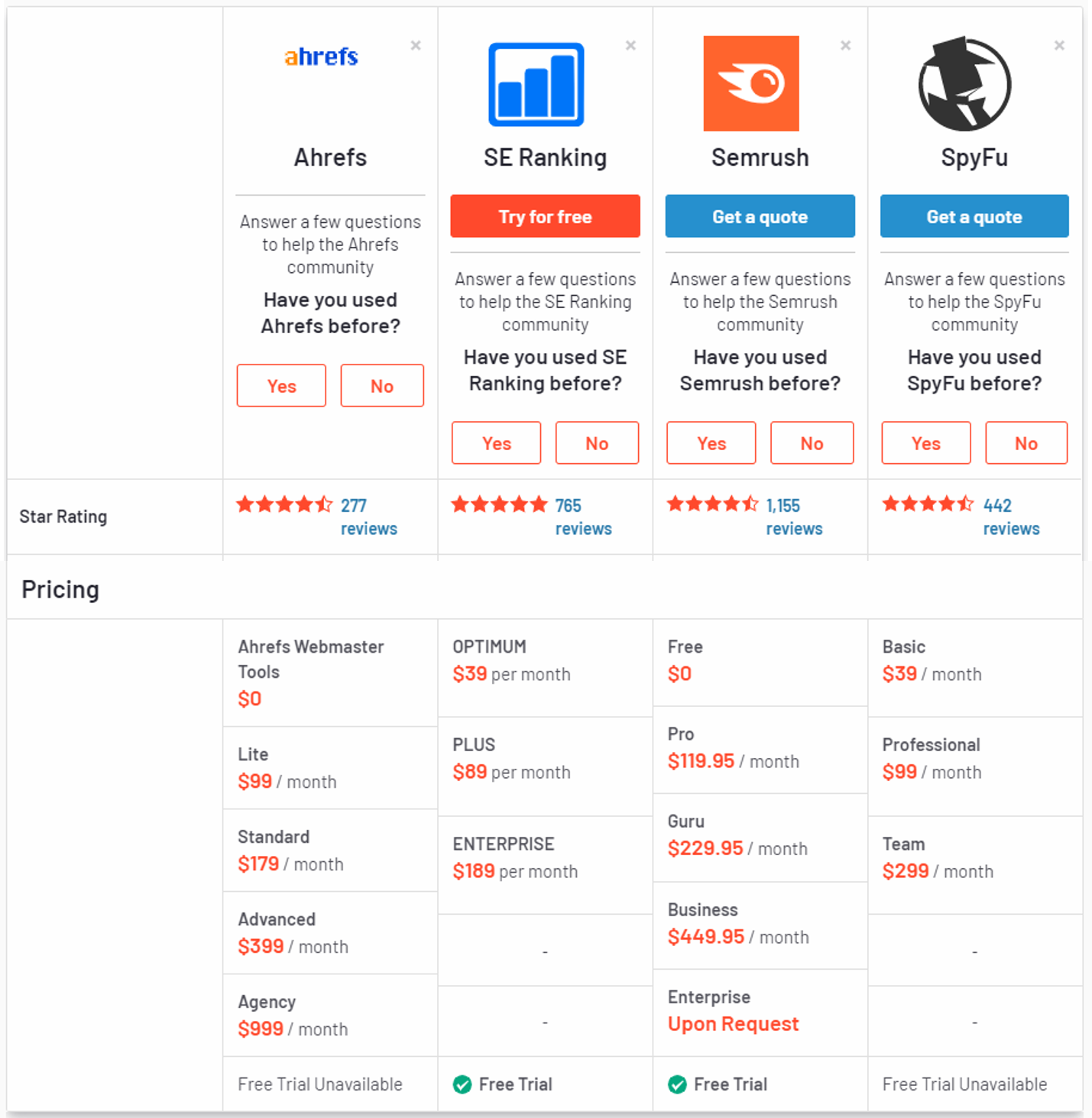
Step #1: Find Your Competitors for SEO
The first step of SEO Competitor analysis is to find your competitors.
So, to find my competitors I will be using SE Ranking Competitive Research tool. Simply, I enter my domain, select my targeted location and click analyze.

I like to use my website for this as you can see my website has still low domain trust, not high traffic, and not many backlinks. Because it is easy to do SEO competitor analysis for well-established websites with domain trust of 60 or higher.
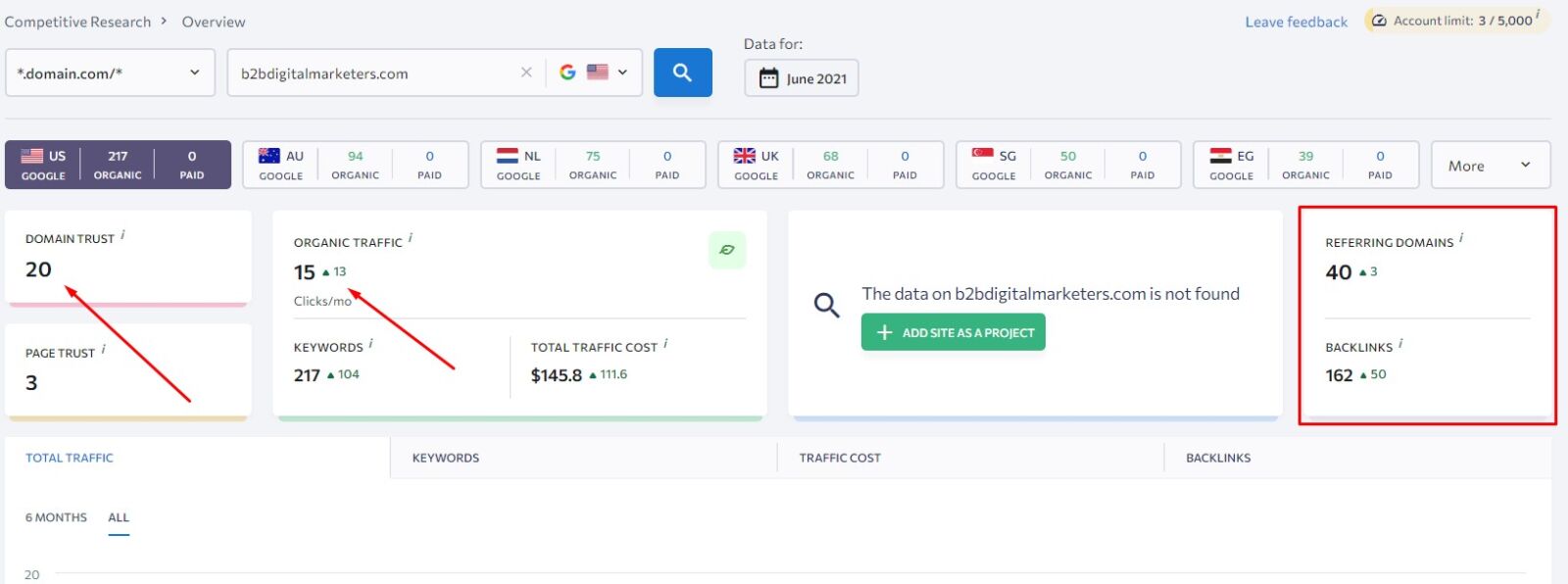
But it is much harder to find keywords, link building, and other SEO opportunities to grow a smaller website, plus I assume your website is small as well, so it will be more helpful to you.
However, if you do or your brand has a larger site, then still you can follow me as there is not much difference, only owners of a smaller website need to do a bit more digging to find SEO opportunities for their website.
Anyway, to go back.
As you can see, I am ranking for around 200 organic keywords according to SE Ranking, which is not many, but enough to find my competitors.
So, to find them, I scroll down to Organic competitors report and click on “View Detailed Report”. Or I can also use the left sidebar and click on “Competitors” in the “Organic traffic research” section.
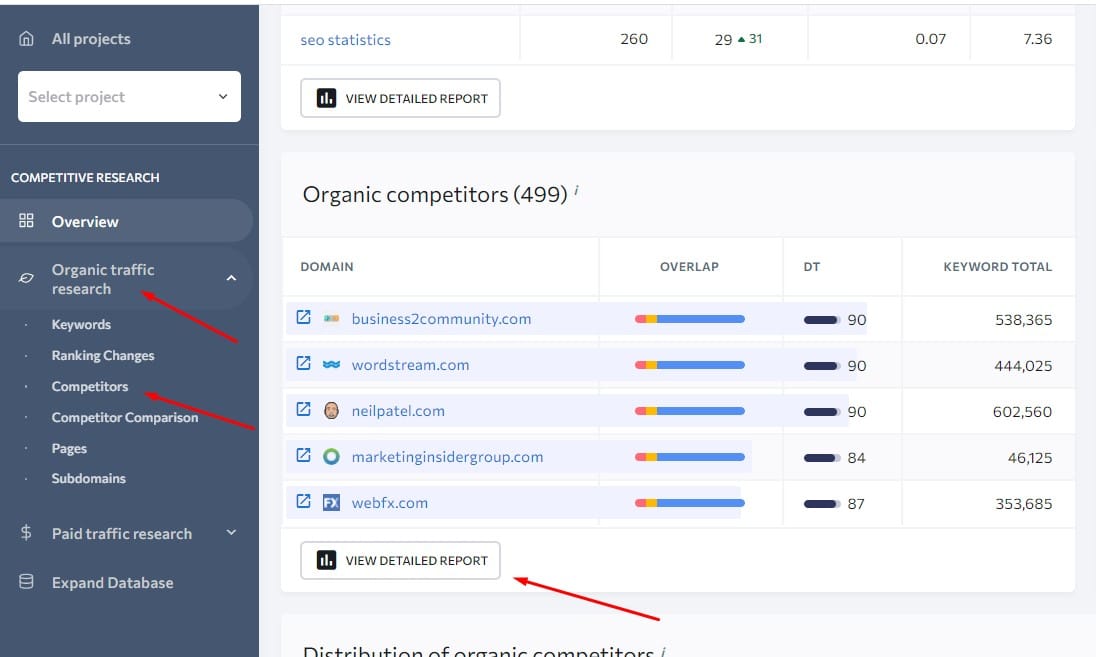
And here I have a list of almost 500 organic competitors that are ranking for the same keyword with additional helpful information.
Obviously, the first websites with the highest number of common keywords are the big sites because they have a ton of content on their website and that’s why the chance of ranking for the same keywords is high.

Second, I can see the missing keywords, these are the keywords my competitors rank for in the top 100 Google search results that my analyzed website does not rank. This is a great source of new keyword ideas, but on this later.
Next, there is keyword total, which is the total number of keywords competitors rank for in Google’s top 100 search results.
And lastly, I can see the organic traffic and the total traffic cost, which means how much you would have to pay to get this traffic using Google Ads.
And that is how you can find your competitors. Of course, depending on the type of SEO tool you are using, the process will differ. However more or less you will get the same information.
Step #2: Analyze Competitors SEO Authority Score
Once you have the list of your competitors the next step is to analyze the list to find the right competitors.
Generally speaking, it’s always better to try to find top-ranking keywords, content, and backlink sources of your competitors with the same or similar SEO authority score.
SE Ranking is using its own quality score to assess website authority on the internet. This is calculated based on the number of backlinks, quality of the backlinks, and many more aspects.

However, you don’t want to limit your reach by just focusing on the competitors in the same ballpark as you.
Thus, I will show you how to find your level competitors and high-level competitors and why you should be focusing on both.
Also, before I get started, I create a basic spreadsheet with the information I want to collect for each of my competitors. This is the spreadsheet I typically use, so feel free to copy this SEO competitor template and use it for your website during this training.

As you can see I have only 5 rows for my competitors. However, I recommend you to find as many as you can or at least 20-30 competitors for each level.
The more you find the more information you get and the better SEO opportunities you will be able to find. But let’s get started.
Find Your Level SEO Competitors
Alright to find competitors at the same level as you are, first, you must know what your domain authority score is. Depending on the tool the number may differ, therefore I recommend sticking with one tool to avoid any confusion.
With that, as I said, SE Ranking is using their own score called domain trust and according to their score, my website has a domain trust of 20.
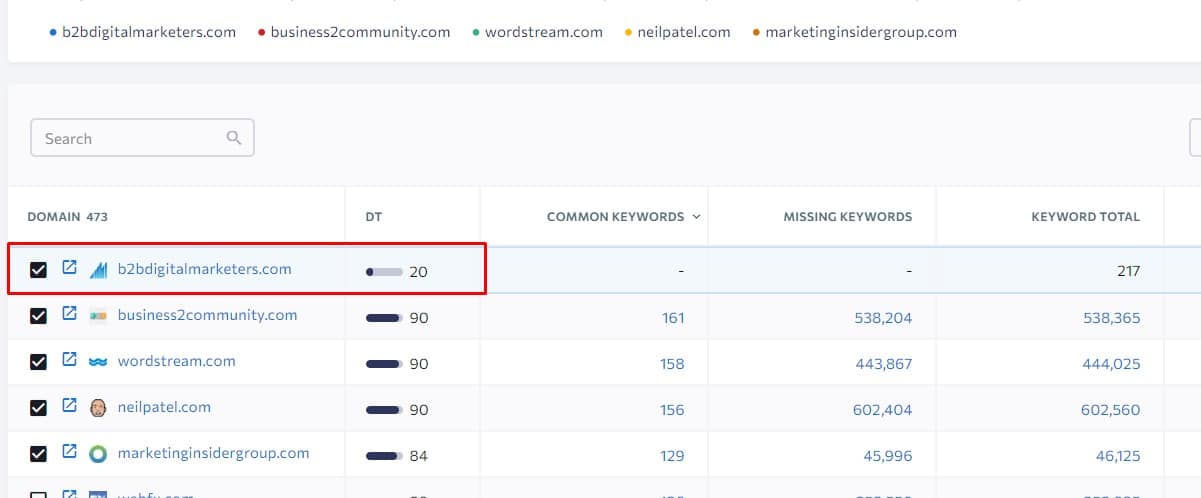
So, based on this and to stick around the same level I will be searching for competitors with domain trust between 10-30. However, if your score is even lower like 10 or even 0, then you can still search for competitors with domain trust of a maximum of 30.
The reason why is because to get domain trust of 30 is relatively easy. Once you complete your SEO competitor analysis, move to backlink competitor analysis, and start executing your SEO strategy for B2B you will be able to get domain trust of 30 within a few months.
Therefore, you can easily outrank your competitors and start ranking for the same keywords as them very soon.
So, to find competitors between 10-30 domain trust I sort the “domain trust” filter by lowest. Now, I just scroll down to the level I want, and I can start adding competitors to my SEO competitor analysis template.
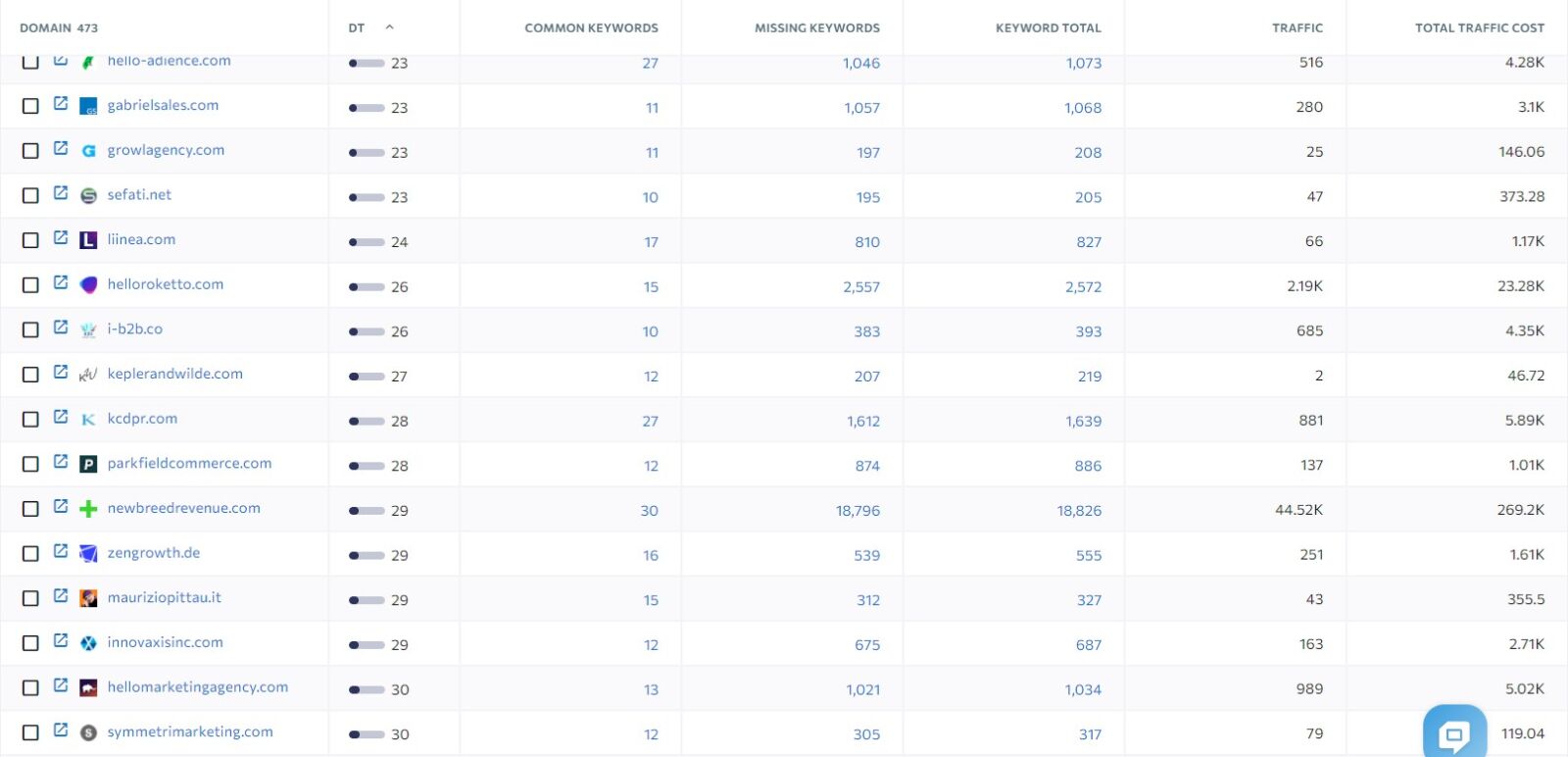
However, this is quite a long list already, so to narrow it down I will only include the competitors with the highest traffic within the range of domain trust score. Again, I am doing it only for the top 5, but I recommend you do this for the top 20 or 30 of your competitors.
So, I exported the data, remove the competitors below 20 and above 30 domain trust, and sorted the list by the highest number of traffic. And here are my top five SEO competitors at the same level.
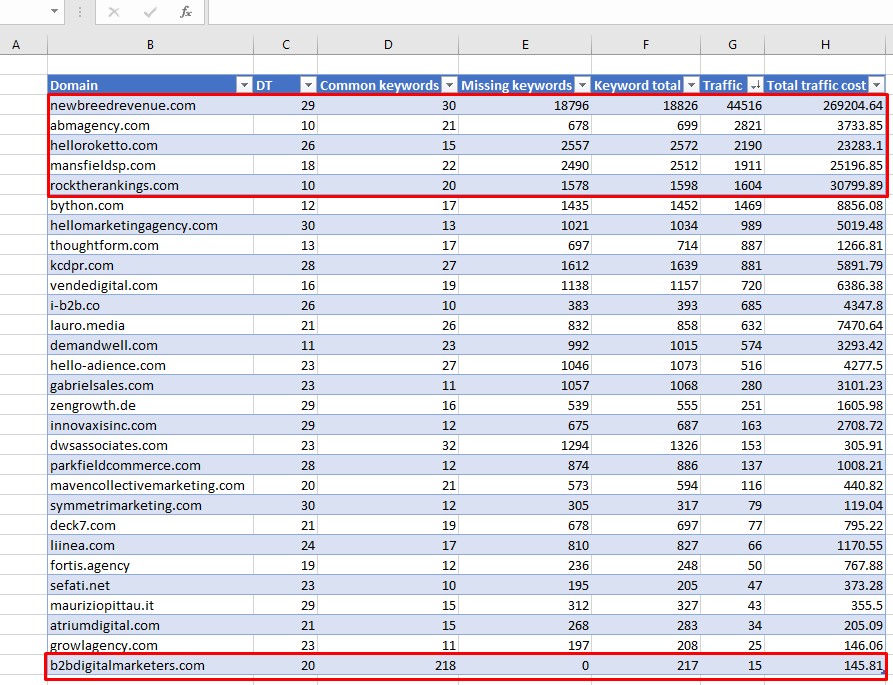
As you can see, they have decent organic traffic. According to SE Ranking, my organic traffic is 15 (Look at the last row). This means these SEO competitors hide a lot of SEO opportunities to grow my organic traffic.
So, now I just go quickly to scan their website to ensure, they are focusing on the same niche and creating content around the topic I am targeting. I want to avoid sites that target different topics like sales or customer service.

All these sites look good, so I take them and include them within my spreadsheet with all the data. Domain trust and traffic are already included within the exported data, but to find the rest I pop their domain in SE Ranking Competitive Research tool and collect the rest of the data.
I can also click on the competitor domain within the “Competitor” report to get the competitive report. And here I can find all the information I need. (Competitor 1 has 767 top ranking keywords in-between position 1-5 and 977 keywords in-between position 6-10. 767+977=1,744 top ranking keywords in-between ranking position 1-10.)
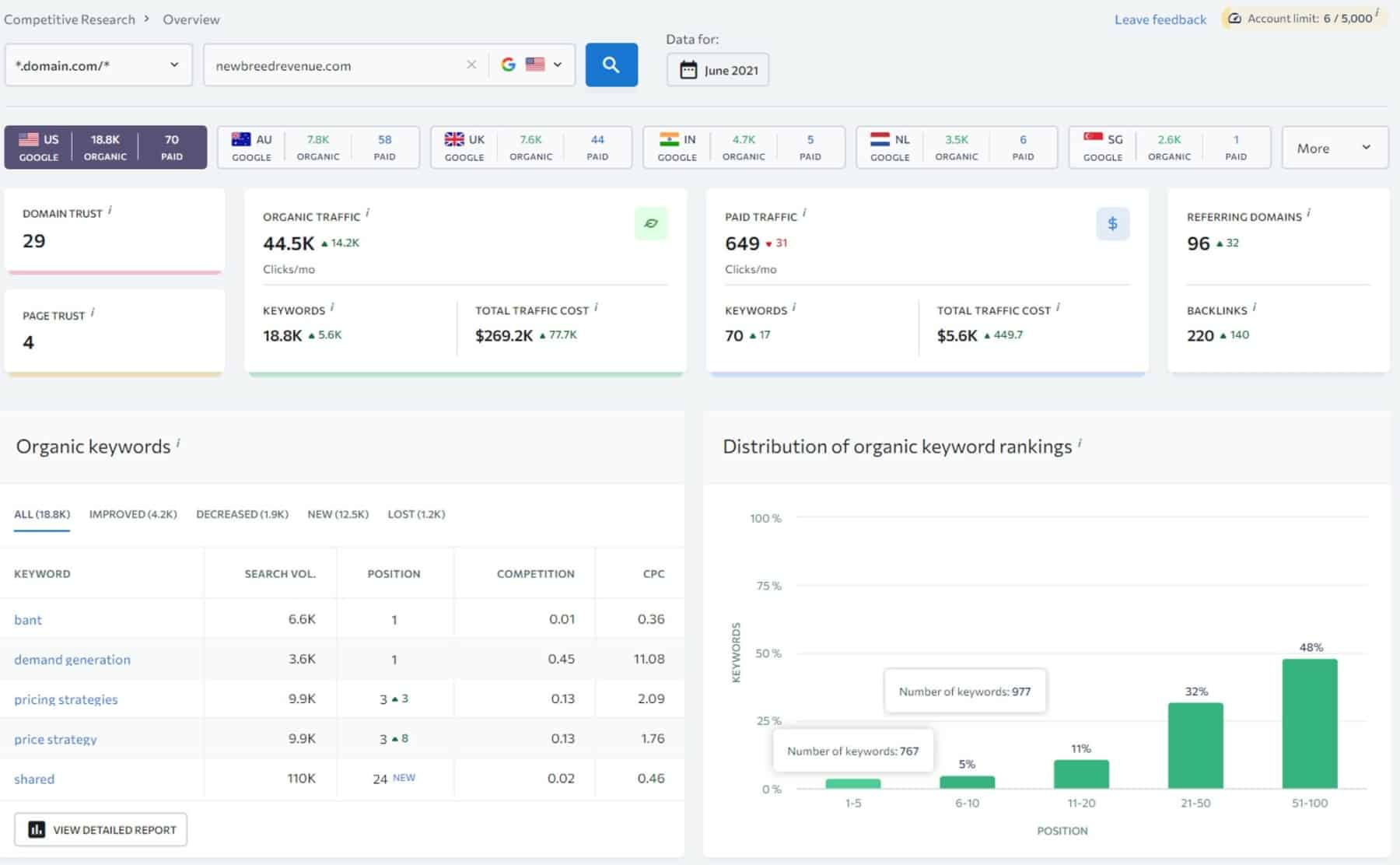
So, I just quickly copy-paste the data into my spreadsheet.
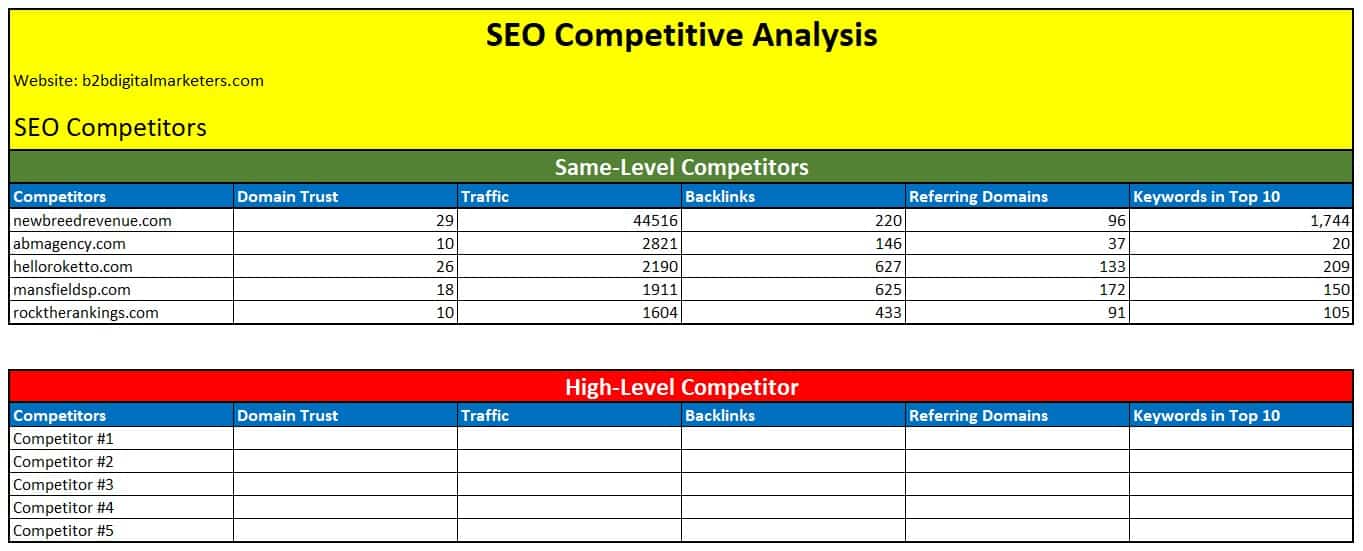
And now I have completed my list of same-level SEO competitors, and I can move to the high-level competitors.
Find High-Level SEO Competitors
To find high-high SEO level competitors I will do almost the same as with same-level SEO competitors.
First, I sort the domains by the highest “domain trust”. Then I will select my top 5 competitors to fill up my spreadsheet. Again, I want to avoid any sites that do not focus on my niche or are focused on a different angle of my niche.
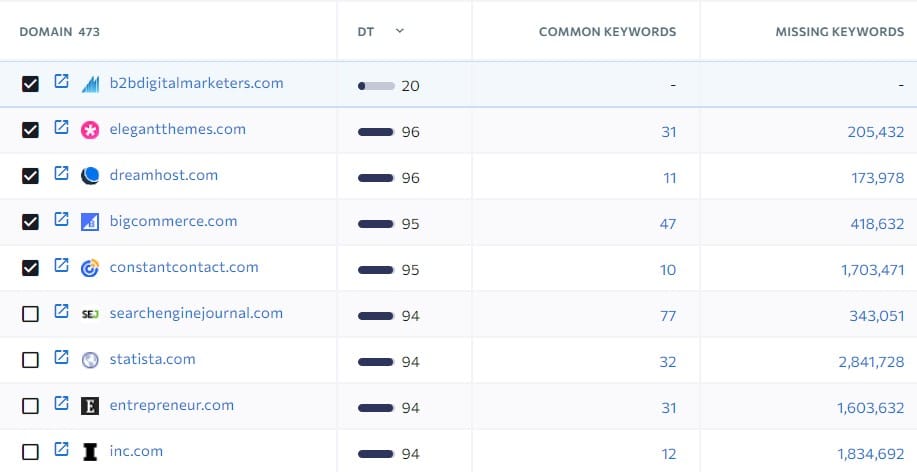
For example, the domain elegantthemes.com is not the right competitor for my SEO competitive analysis because they are focusing on topics around WordPress.

The same applies to dreamhost.com, they are focusing on the same topics as me, however, then they have way too many other different topics like WordPress, Web Hosting, Website builder, and Design. Thus, this is not good as well.
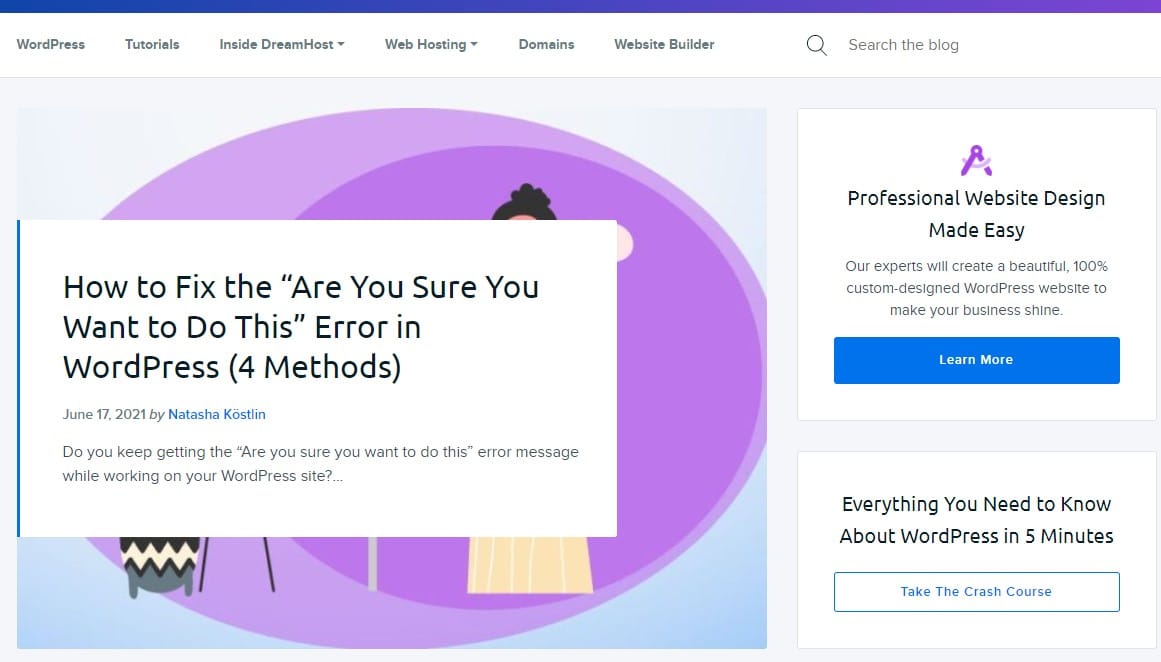
So, this is important to go through the competitor’s website and see what topics they are writing about. If they are having topics that you know you will not be targeting any time soon, then you want to move to the next.
As I said, you want to find SEO competitors that match your targeted topics. For example, my targeted topics for the next two years are SEO, Content Marketing, and Lead generation for B2B.
So, topics like e-commerce SEO or B2C marketing, WordPress, website design, hosting are topics that I will not be targeting any time soon. Therefore, I need to find websites that fit my targeted topics as close as possible.
However, because these sites are already large enough, there is a very small chance that they will not have other topics that I do not target.
So, I went through the list and scan the competitors website and find these top five competitors that are close to my targeted topics.

Step #3: Perform Competitors Keyword Analysis
The third step of SEO competitive analysis is to do keyword gap analysis or also called competitors keyword analysis to find keyword opportunities to grow your organic traffic.
Competitor Gap Keyword Analysis means searching for keywords your competitors are ranking for and they drive them organic traffic that you are missing.
As you might realize, that’s why it’s so important to find same-level competitors, because if their website is ranking for the keyword and it drives organic traffic to their website, thus your website can too.
Also, doing keyword gap analysis for high-level competitors is important as well, because as you will see, they rank for tens and even hundreds of thousands of keyword ideas. Thus, there is a good chance to find untapped keyword opportunities.
With that, to start with keyword gap analysis you’ll need to go back to your SEO tool. Again, this will slightly differ depending on the tool you are using. However, most of the SEO tools are having keyword gap analysis, just they might call it differently.
For me, because I am using SE Ranking, they call it “Competitor Comparison”. Here I will add two of my competitors from the spreadsheet and click on “show results”.
Keyword Gap Analysis for Your-Level SEO Competitors
I usually start with competitors at the same level and then move to the high-level competitors.
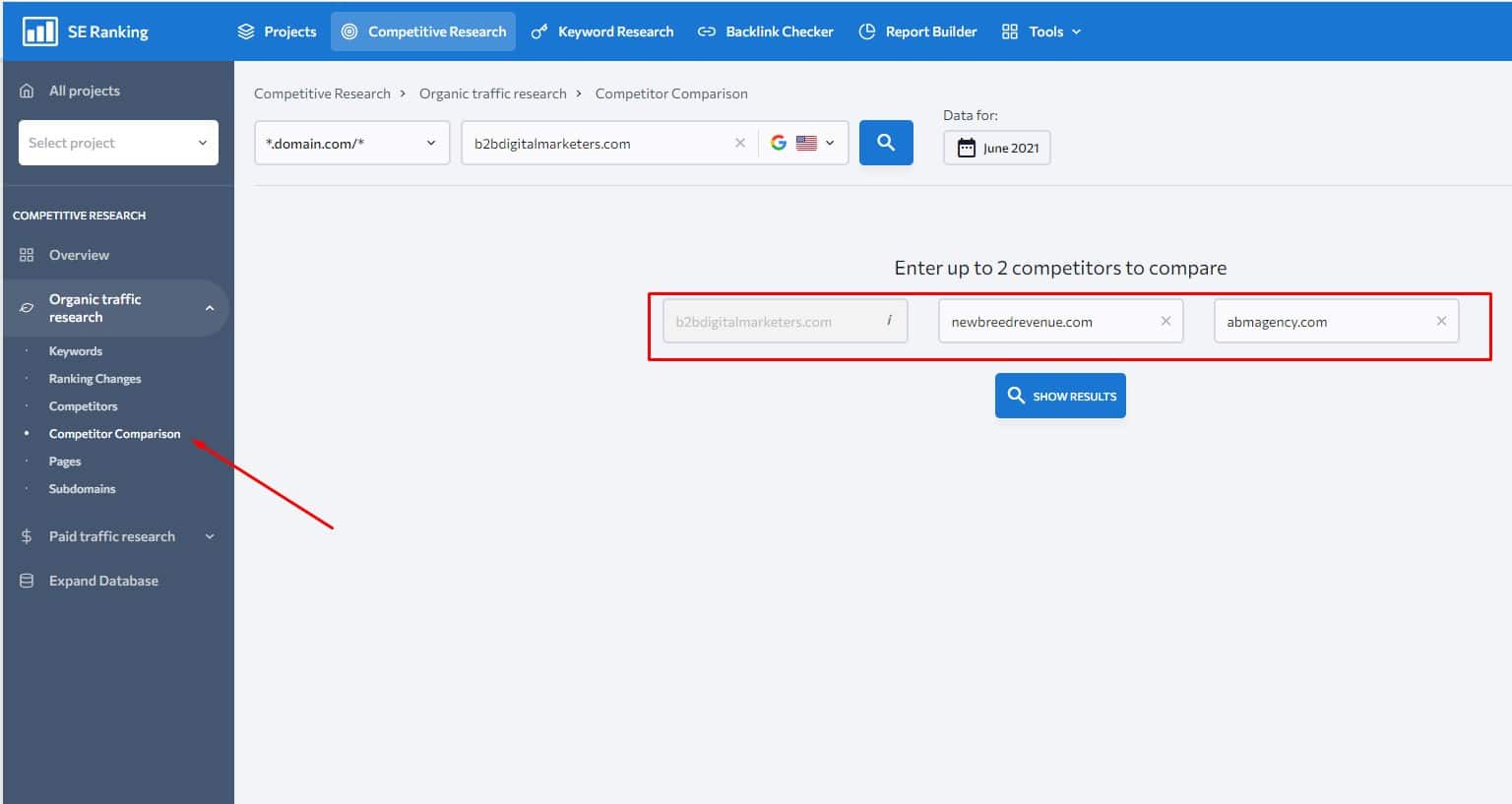
And here you will see nicely the keyword combinations that show you how many unique keywords each domain has. Obviously the larger the circle the more unique keywords the domain has. Also, you can see the traffic and keyword competition of each analyzed domain.

And when I scroll below, I can find four tabs, “All keywords”, “Common Keywords”, “Missing Keywords” and “Unique Keywords”.
Now, because I started keyword gap analysis also called content gap analysis with same-level SEO competitors so I want to see keywords my same-level SEO competitors are ranking for in top position because then I have a chance to rank in top positions as well.
Thus, I will select my competitor domain and select the “unique keywords tab.

And here I have a list of all keywords my competitor domain is ranking for along with their current ranking position. Now, I only have to scan the keyword list to find any keywords my competitor is ranking in the top 10.
Once I find such a keyword and it has enough search volume that it would make sense to me to target the keyword, then I include the keyword within my SEO competitor analysis spreadsheet under the Keyword Gap analysis.
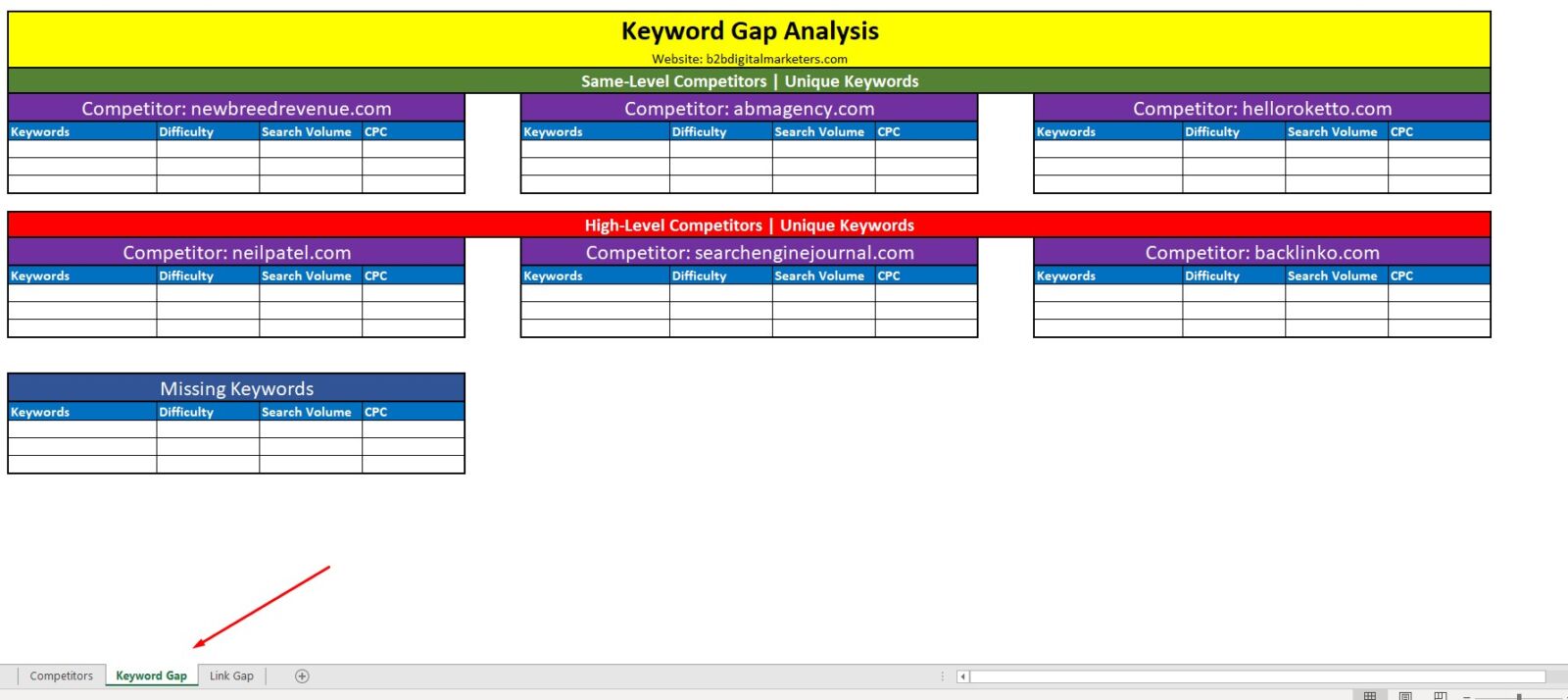
Such keyword example could be “position marketing”. My competitor is ranking in the top positions, it has great search volume, and even the CPC is high.
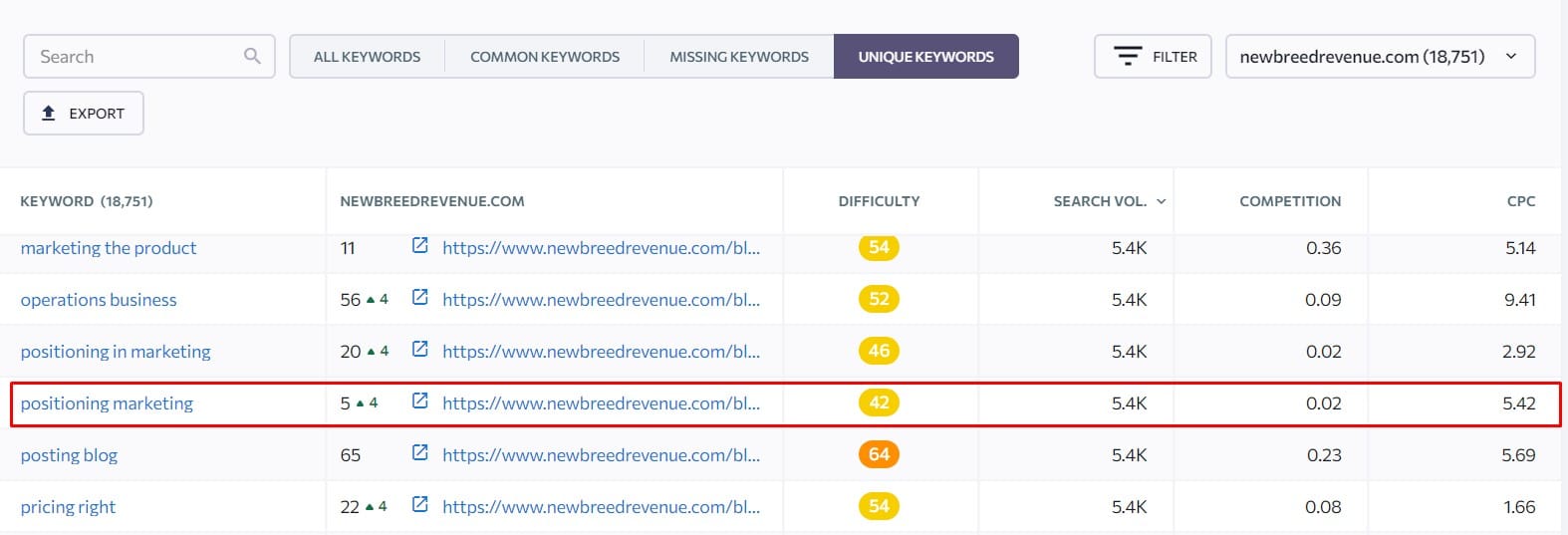
So, let’s pop it into the spreadsheet under the unique keywords for analyzed competitors.

Obviously, your template will be much longer and not just 3 keywords per competitor. This is only for demonstration.
Keyword Gap Analysis for High-Level SEO Competitors
Now, let’s move to the high-level competitors. However, I recommend you do this technique I am going to show you also use for your same-level SEO competitors as well.
So I go back to SE Ranking Competitor Comparison tool and enter two of my high-level SEO competitors and click on show results.
Now, because I am searching for keywords my website is missing, I will select my domain and select the “missing keywords” tab.
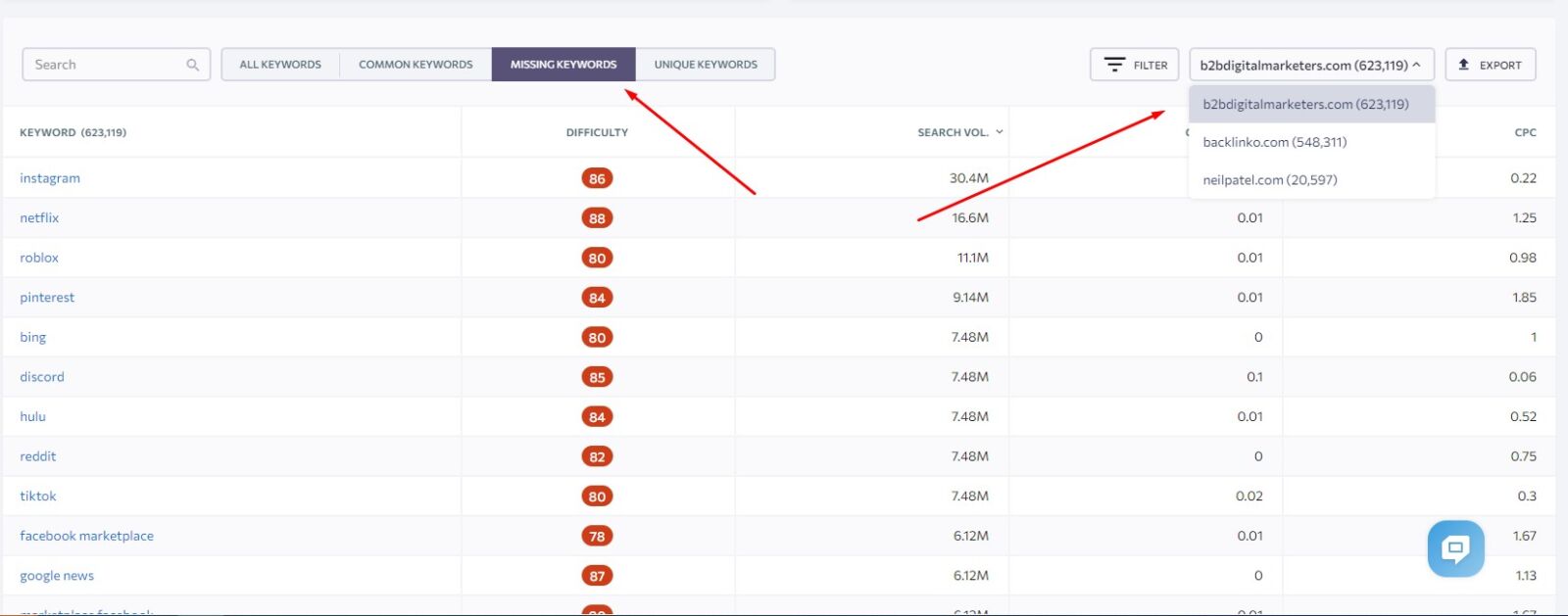
And here I have a list of keywords my competitors are ranking for, but I don’t. And as you can see, I am missing over 600K keywords. That’s a lot of keywords. So, I can set some filters to narrow down the list and improve the quality of keywords such as “Difficulty” and “Search Volume” filters.

Now, I only have to scan the keyword list to find any keywords that make sense to me to target and have a decent search volume. An example of such a keyword could be “business leads” as I am focusing on B2B marketing.

This keyword has a very low difficulty score, decent search volume, and high CPC which shows me the keyword has high commercial value.
So, I pop that keyword in my SEO competitor analysis spreadsheet in the keyword gap section. But because I cannot track who is ranking for this keyword I just put it into the missing keyword section.

Of course, if you want to track the keyword who is ranking for it, you can analyze one competitor at a time. I honestly think it’s better to do that but to make it easier for this tutorial I track two SEO competitors at the same time, but you can make your choice what you prefer.
With that, now I recommend you do this for both the same & high-level SEO competitors and you will get plenty of keyword ideas you can rank for!
Step #4: Perform Competitor Backlink Analysis
The next step is to perform competitor backlink analysis, also this is called link gap analysis.
This means we need to find how your competitors are getting backlinks to their website so we can mimic the best strategies and get backlinks to your site.
Many do the mistake once they have their list of keywords, then they start producing content to target the keywords.
And while it is not totally wrong, you must understand that there are essentially two types of content you should focus on:
- Content to bring organic traffic: This is when you do your keyword research to find relevant keywords to your niche and then create content on your website to target those keywords and attract your target audience.
- Content to generate backlinks: This is when you find link building opportunities such as broken pages and then create content to attract links to your website.
It’s not a secret that the two most important Google ranking factors are high-quality content and building backlinks.
Yes, that means for the best SEO performance you need to create two kinds of content on your website to drive the best results.
Therefore, you must do competitor backlink analysis to find link building opportunities for your website. I have a video where I teach you how to do it in the step-by-step process which you can watch here:
However, let me show you here what you should be focusing on when you are doing competitor backlink analysis and some ways to find link building opportunities for SEO competitor analysis.
But before we get started I recommend you create another tab in your SEO competitor Analysis spreadsheet. Here is an example of mine.
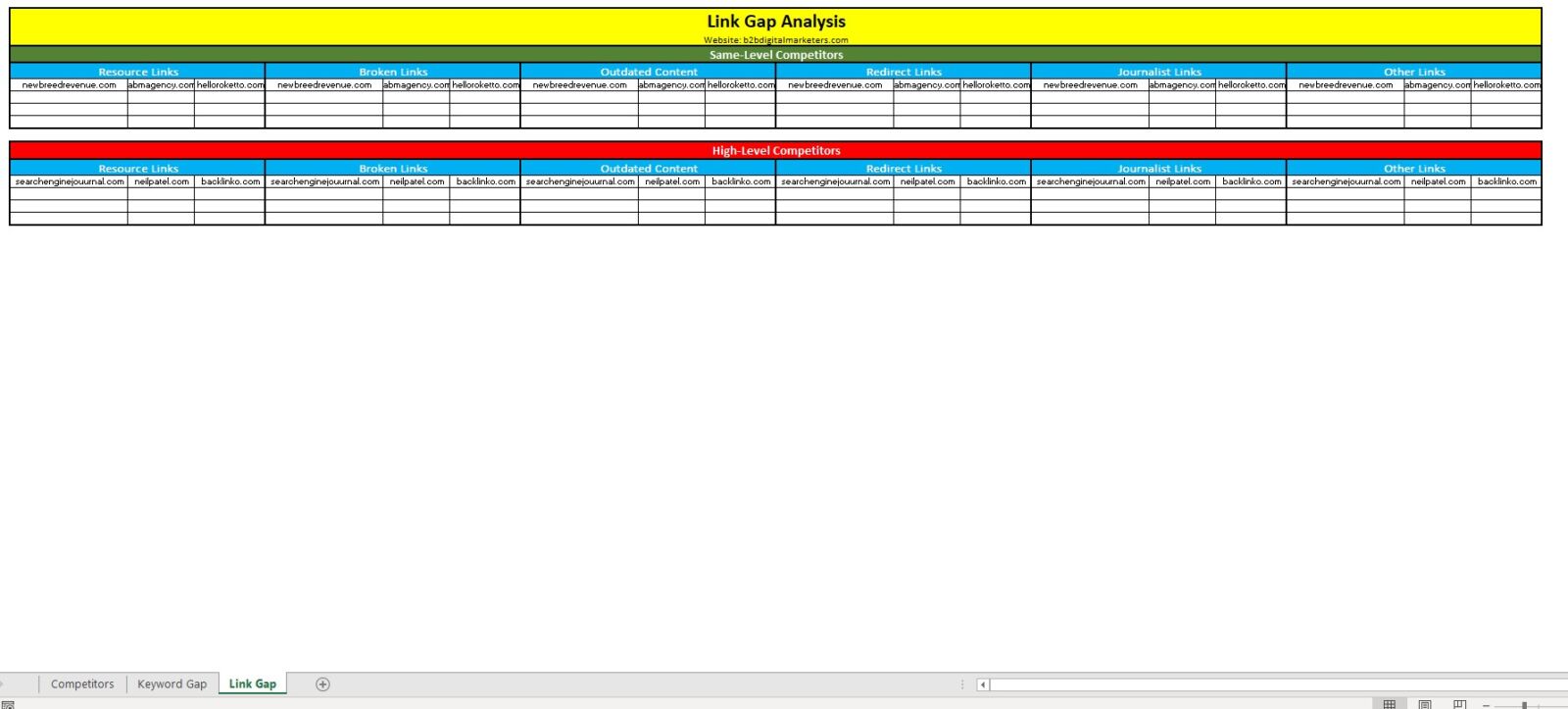
(Find the full picture here)
Top Competitor Content
The first way to figure out how your competitors are getting backlinks is to look at their top pages by the highest number of backlinks.
Here you want to find pages that are generating a lot of high-quality backlinks, understand what makes them so linkable and then produce better content.
To do that I will use SE Ranking Backlink Checker. Here, I will enter my high-level competitor because they probably have hundreds or even millions of backlinks pointing to their website including any gov backlinks and edu backlinks. I start with searchenginejournal.com.

Here, I have all the information about SearchEngineJournal backlinks and referring domains. As you can see, they have over 40 million backlinks from over 200 thousand referring domains.
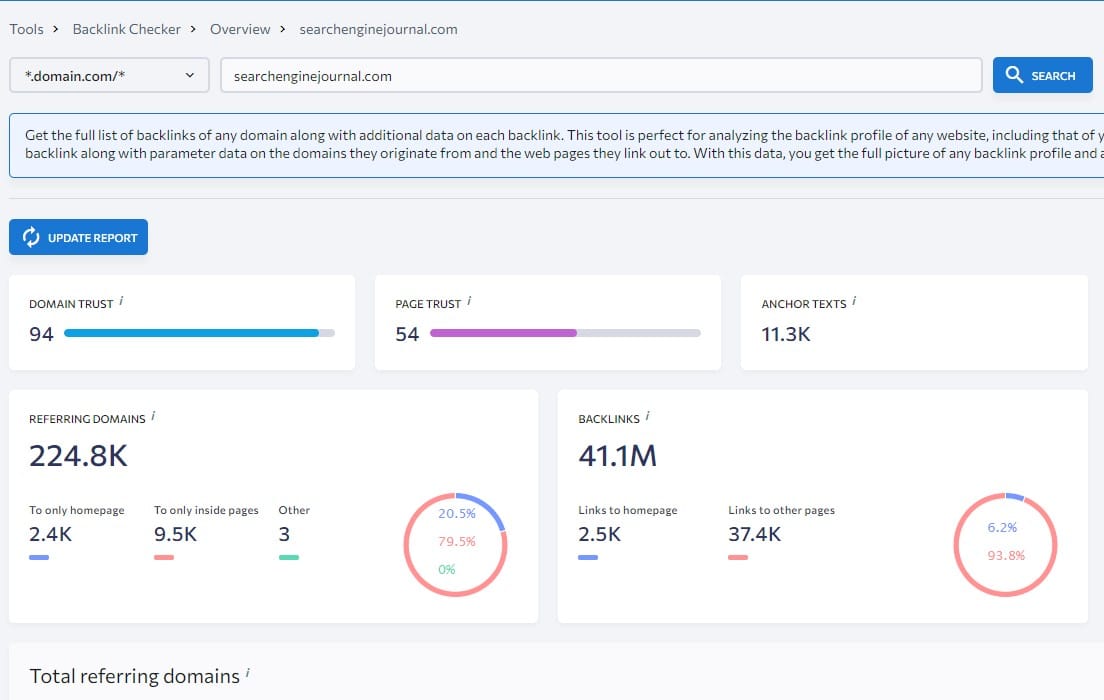
So, to see what pages generate the highest number of backlinks I select the “Pages” report.
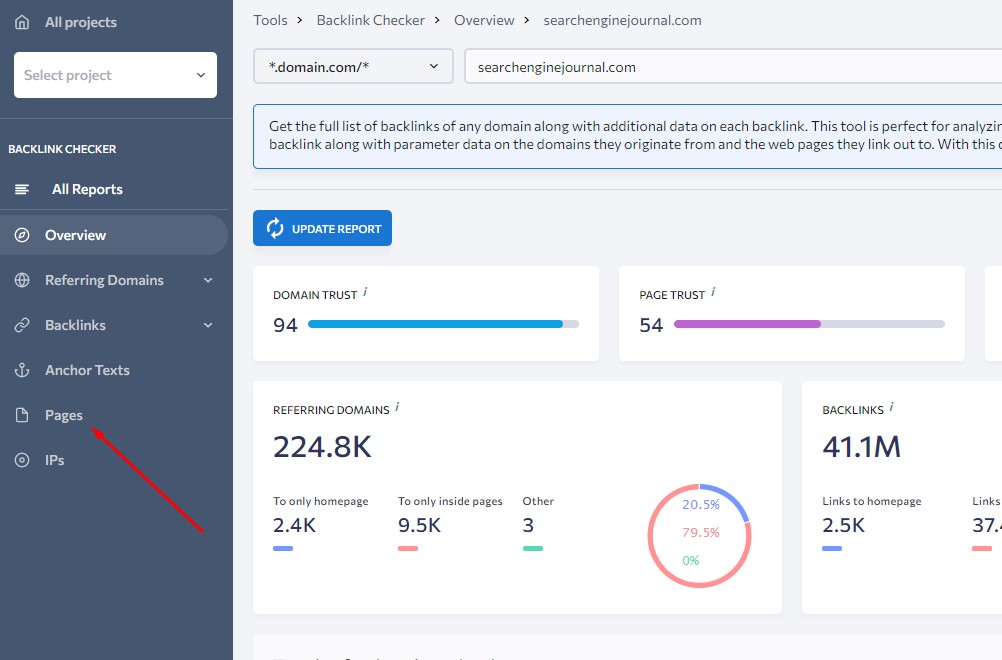
And here I can see all the pages or content that attracts links to the page. With SearchEngineJournal there are a lot of backlinks pointing to their images.

And while custom images are a great way to earn backlinks and you should create your own custom images whenever you can, but when I look at the referring domains pointing to their images, I can see these websites are those low-quality spammy websites that scrape pictures from other websites.

Obviously, something like this I want to avoid. What I am looking for are pages that are old, low quality, outdated, redirected, or broken, so I can improve on them and then start with blogger outreach.
So, I am scanning the list and opening any informational content published on my competitor website and I have found that one of their blog posts about SEO statistics is redirected to a different SEO statistics post.

And I am seeing a lot of domains are linking to a certain statistic “93%” and when I do a quick search if such statistic exists on their page, it shows me no results.
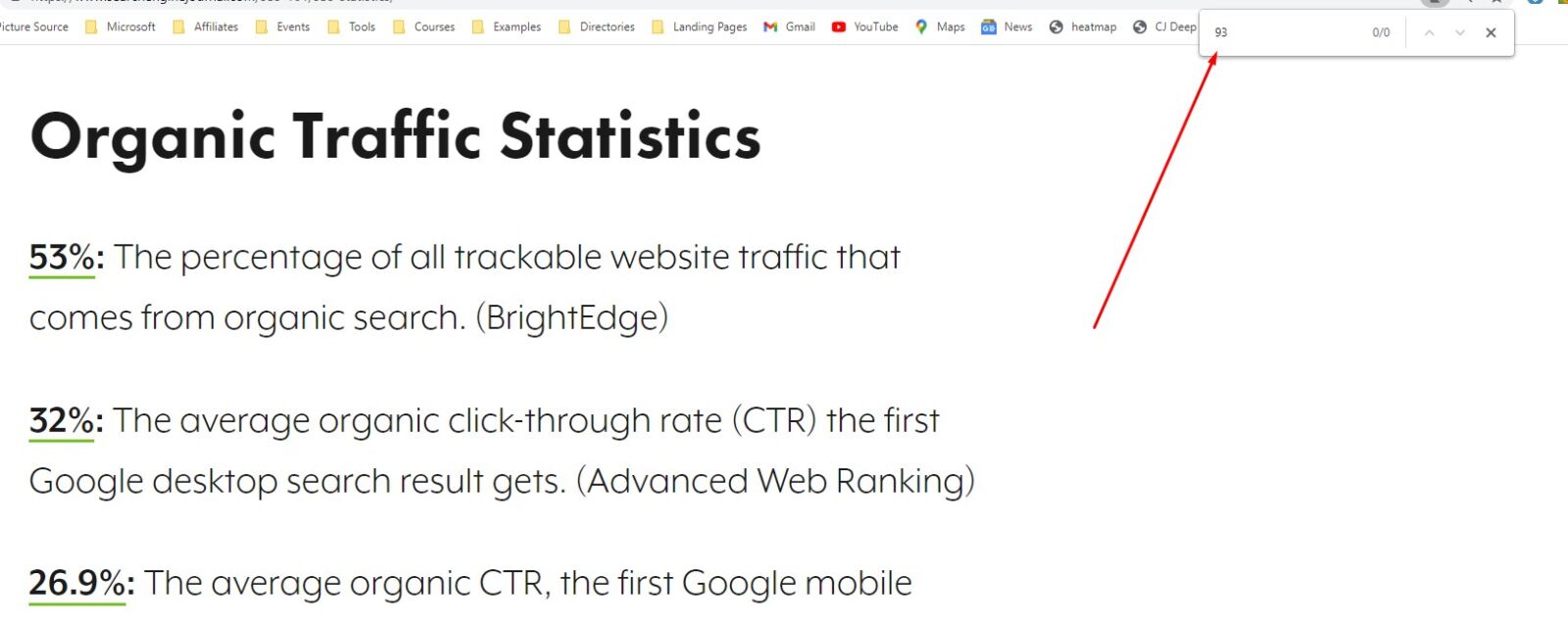
This means they have updated their web page and deleted this statistic. This means I have to find such statistic on the internet that is up to date, include it within my SEO statistics web page, and then reach out to the referring domains and inform them that this statistic has been deleted and offer them my up to date statistics with the current trend.
On top of that, I have also found out that the statistic is incorrect and the author of the statistic has no proof of such claim.
So, this is a great opportunity, so I include it within my spreadsheet to not lose it and move one to search next one.
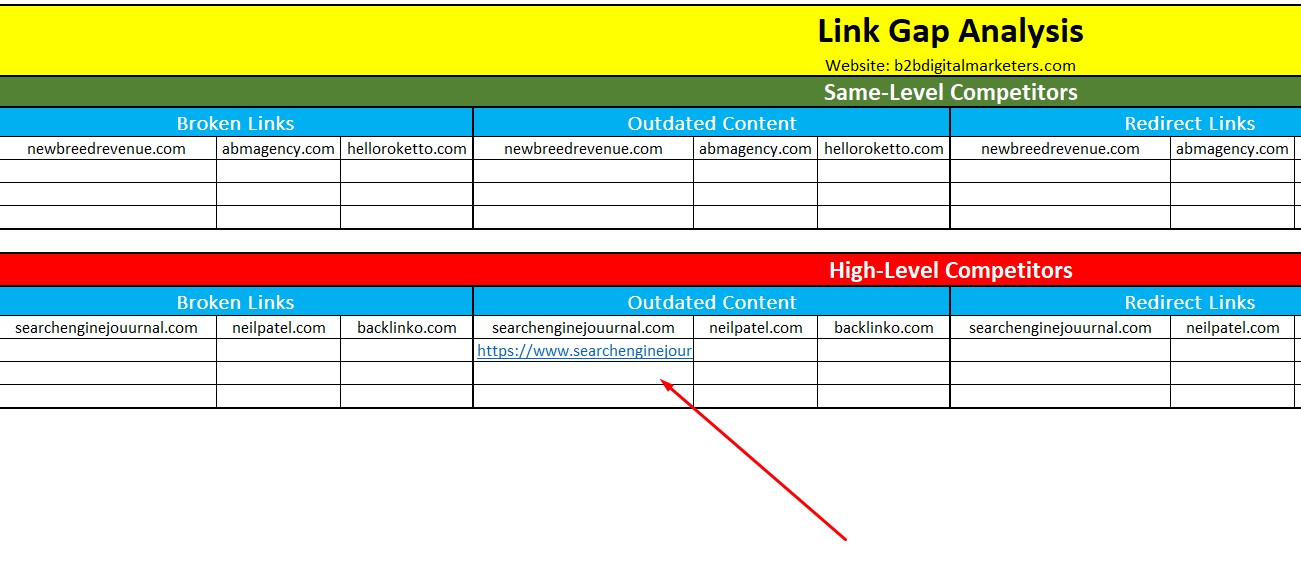
And this is just one example, but going through your competitors top content you can find more link building opportunities so you can create content to grab those backlinks just like me.
All Competitor Backlinks
And the next place where you can search for link building opportunities or link-gap opportunities is to check all backlinks of your competitor.
This is a powerful strategy if you know how to use it. Because just having the list of all competitor backlinks is no use if you don’t know what you are searching for.
So, the best link building strategies you can use when you have the list of all competitor backlinks are:
- Guest Blogging
- HARO Link Building
- Link Insertion
- Resource Link Building
- Niche Edits
- Skyscraper technique
- Broken Link Building
With that, let me show you how you can get the list of all of your competitor backlinks. I head over to SE Ranking Backlink Checker and enter my competitor domain.

Then I open up the “Backlinks” report by clicking on the number of backlinks.
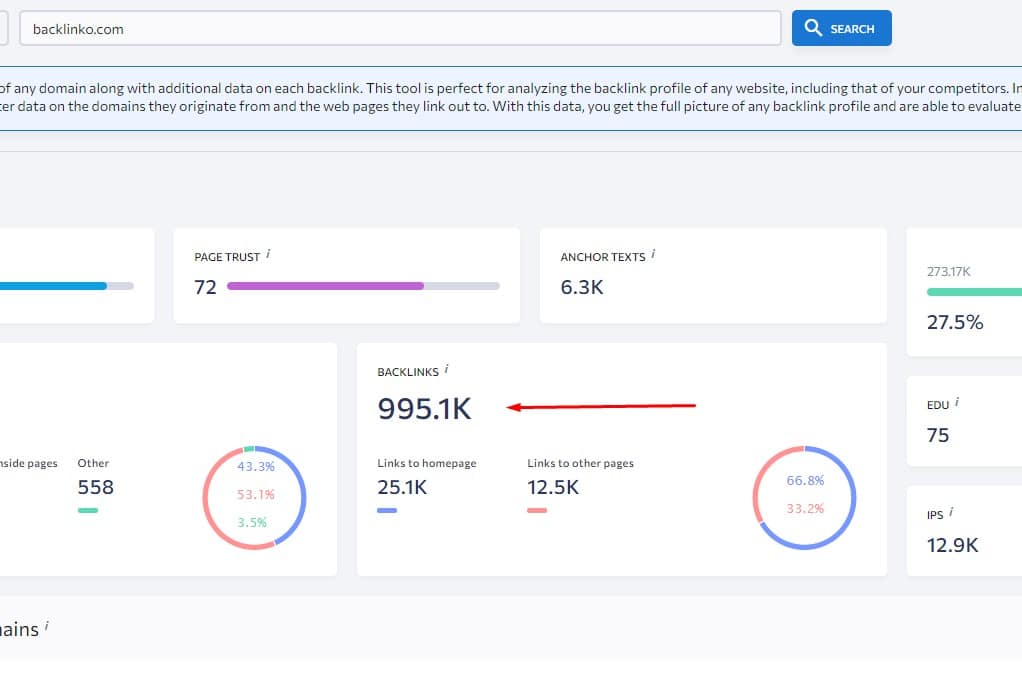
And here I have the list of all Backlinko backlinks. Now depending on the link-building strategy, I choose I will proceed.

Let’s say for example I want to find resource pages that link to Backlinko. So, to do I can use the URL filter and enter any word that commonly appears in the URL of resource pages and such words could be:
- Links
- Resources
- Examples
- Helpful links
- Best
- Blog
- Best blogs
Let’s for example use the word “Examples” to find any URL with this word in it.

And right away I can see some great link gap opportunities for my own website.
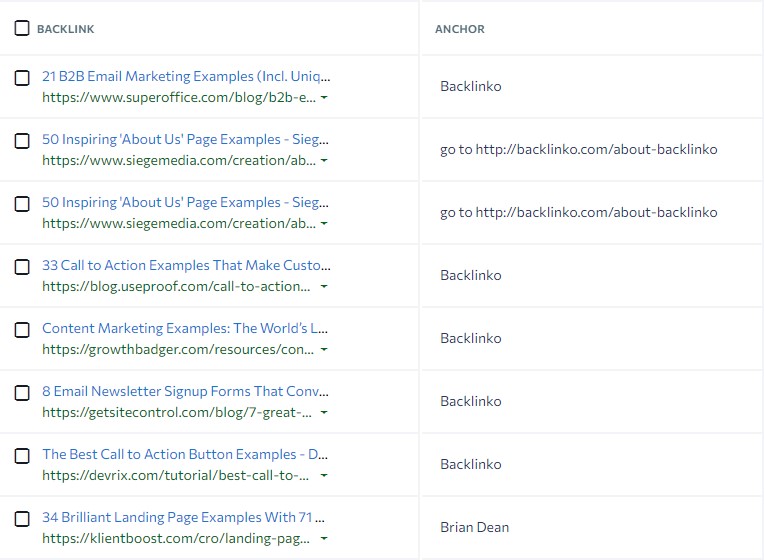
For example, the first from superoffice.com is a great opportunity. They have a list of B2B email marketing examples and what I can do now is to find out what examples they are missing and offer them to write the example for them.
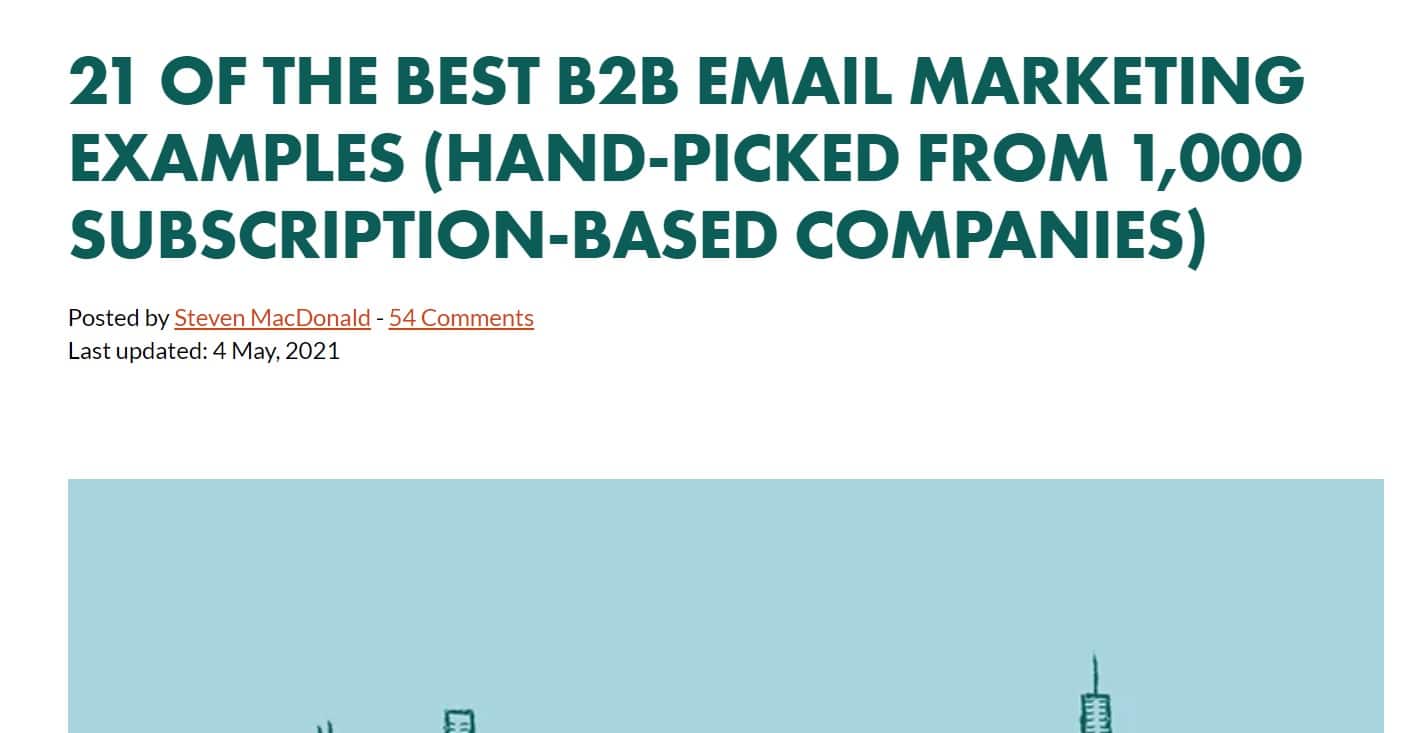
Like this only what they have to do is to copy-paste the example from me if they accept my offer. So, that’s what I did right away when I saw this opportunity. Email Steven by finding his email using hunter.oi.

But for you, I recommend you to first save all the link building opportunities you find in your spreadsheet and then launch your link building campaign.
Either way, performing link gap or competitor backlink analysis is the next essential step for your SEO competitor analysis. Remember if you want to outrank your competitors, you’ll need at least the same number of high-quality backlinks as your competitors.
Step #5: Perform On-Page & Technical SEO Analysis
The next step is to perform on-page & technical SEO analysis on your competitor websites.
While having great content and a lot of backlinks is one of the most important ranking factors, it is not everything.
You must also ensure your on-page SEO and technical SEO is at the same level or better than your competitors. To learn more on on-page SEO you can watch my video here:
To find out how your competitors are doing, just take your SEO tool, plug their domain into the website audit tool and see their health score.
For example, in the SE Ranking Website Audit tool, my website health is around 60 out of 100. It shows me all the errors in a nicely organized and very visual way.
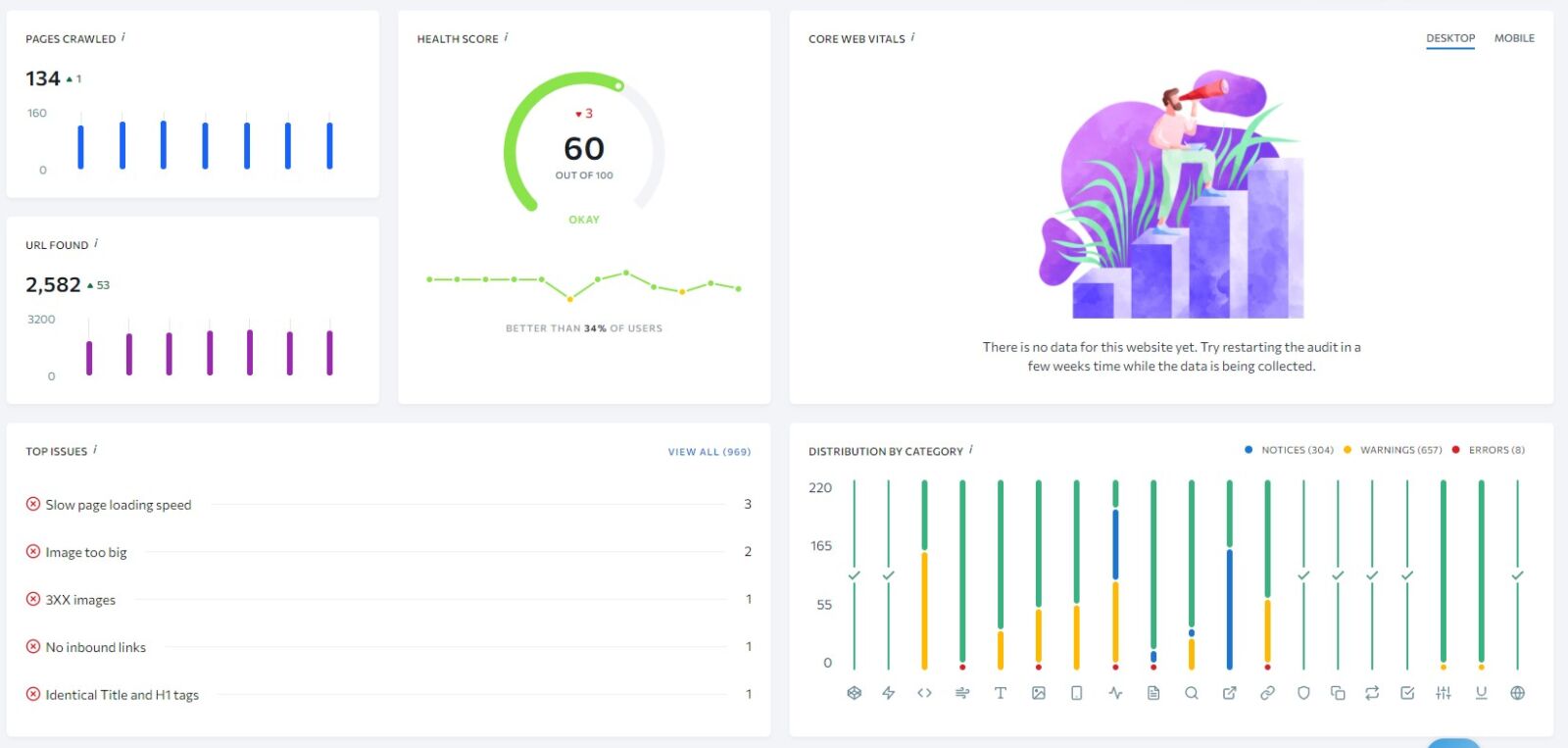
I prefer SE Ranking Website Audit because in other tools like Ahrefs Webmaster tools their site audit shows me my website is nearly perfect. Note, both site audits were run on the same day.

However, SE Ranking gives me the reality that there is still so much to improve, like page speed, image sizes, redirects, no inbound links, etc. All these are ranking factors that can decide whether I rank in top positions or not.
Especially in competitive niches like SEO and Marketing, these small things matter the most, because everybody has done their basics, so you compete on these nitty-gritty things.
But of course, the more pages you have on your website the harder it is to keep your website optimized. For example, I crawled 1,000 pages on one of my competitors.
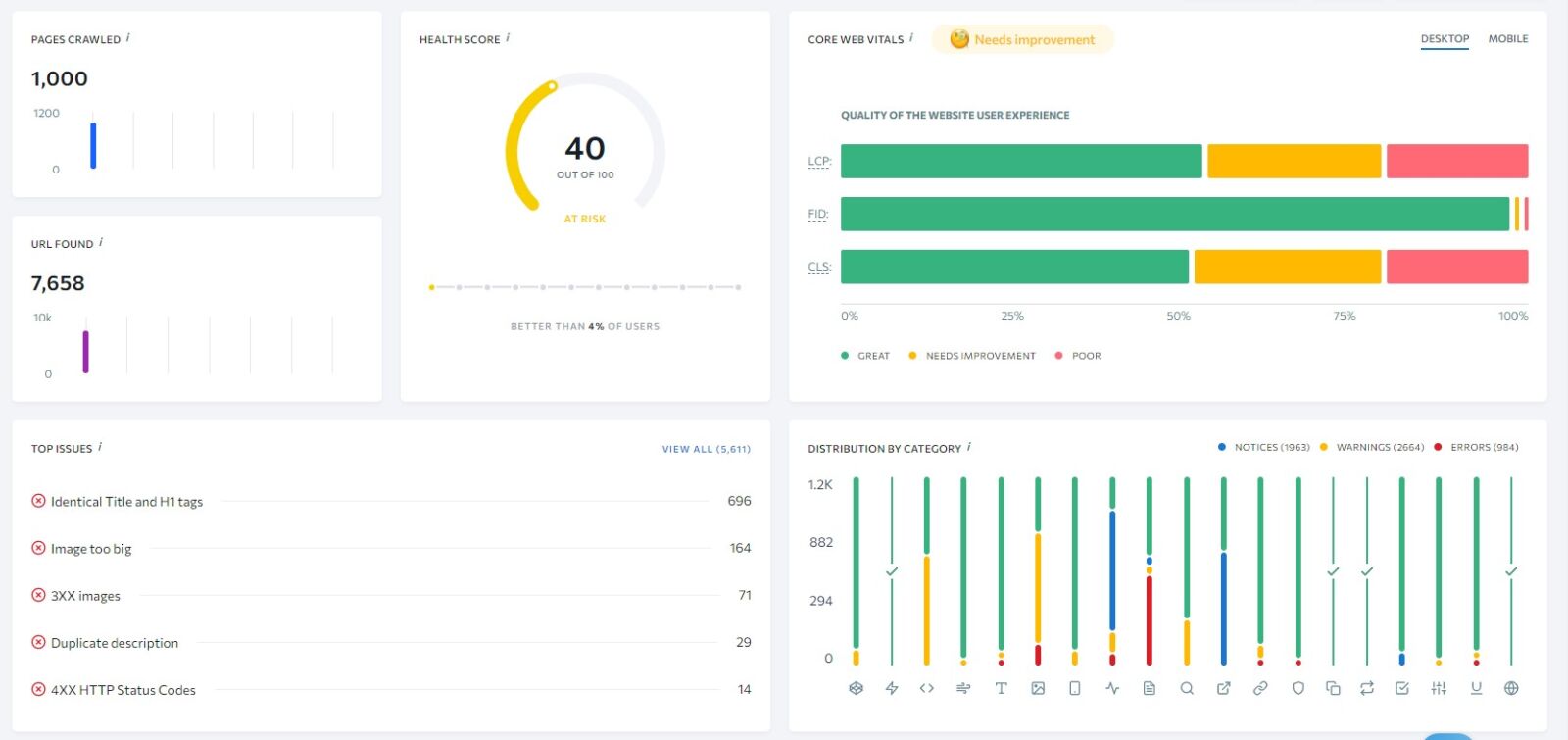
And their score is much lower due to that. That is why the larger site you have, the more care you need to give. This means if I have 1,000 pages I should have at least the same or better overall health score of my website to outrank my competitor.
However, this doesn’t mean just because you have more pages your website’s overall health score will be lower by default. It means, you just need to put more effort. The optimal score should be at least 80 out of 100.
Single On-Page SEO Analysis
Once you understand once your competitors overall site health, then it’s time to move to the single On-Page SEO analysis.
Before you start writing content on your website to compete on the keyword, first you must understand how well your competitors optimized their ranking pages, so they rank in top positions.
Let’s say I want to compete for the keyword “on-page SEO”.
So, I take the top-ranking pages from Google and put them into an SEO Page Checker. I use the SE Ranking On-Page SEO checker and click on “Run the Audit”.

Once the audit finishes, the tool gives you the complete on-page SEO picture of what your competitor has done right and what is wrong there. It gives you information like
- The domain age
- Backlinks for the website
- Content analysis and uniqueness rate
- And tons of more important on-page SEO factors
So, once you will be creating content on your website all this information will help you to improve your content to provide a better user and search engine experience.
However, if you do not use any SEO tool, you can also use Google Chrome Extension like from Detailed.com. It’s a great extension and Glen is using it to perform a six-figure SEO audit.

Step #6: Write SEO Content
And the last step of your SEO competitor analysis is to put everything together and create content that your users and search engines will love.
I have the full tutorial here on how you can write SEO content that ranks #1 on Google that you can watch here:
So, I will not explain it again here as that’s for the next 20-30 minutes topic.
However, I want to share with you some tips when you are writing SEO content:
- Never over-optimize for keywords. Google is smart enough to understand related words to your keyword to understand the topic. Therefore using LSI keywords is important.
- Always write your content first and then optimize for SEO but don’t sacrifice your quality.
- If you are serious to grow fast. Always have an off-page SEO strategy for your newly published article.
- Always perform on-page SEO optimization for every of your page.
Google is doing its best to understand your content without you stuffing your targeted keywords everywhere and getting rich keyword backlinks from shady websites.
Their machine learning algorithm such as MUM is made especially to better understand the user intent and the published content without top-level SEO optimization.
Not everybody is experienced SEO and it shouldn’t be that you need to be an SEO expert to get discovered on the internet. If your content provides tons of value to your users, then you have the most important SEO factor covered!
Best SEO Tool for Competitor Site Analysis
And the last things I want to share with you are my favorite SEO tools to complete your SEO competitive analysis much faster and get the data you need to make informed decisions.
SE Ranking

The first SEO tool I obviously will recommend to you is SE Ranking.
SE Ranking allows me to scan my competitors under a microscope and find the most hidden SEO gems to grow my website. It allows me to easily review the effectiveness of my website and it provides an amazing amount of insight into how I can improve it.
They provide high-quality, easy to use and comprehensive SEO tools that allow me to share information with clients.
SE Ranking gives you everything you need from an SEO tool at a much more affordable price than their competitors.
On top of that, they provide world-class customer service and help you to solve any issues or provide expert advice whenever you don’t know how to do something with their tool.
Definitely, if you consider an SEO tool, then I highly recommend starting with SE Ranking!
Try SE Ranking for 14 days for free ->
SEMRush
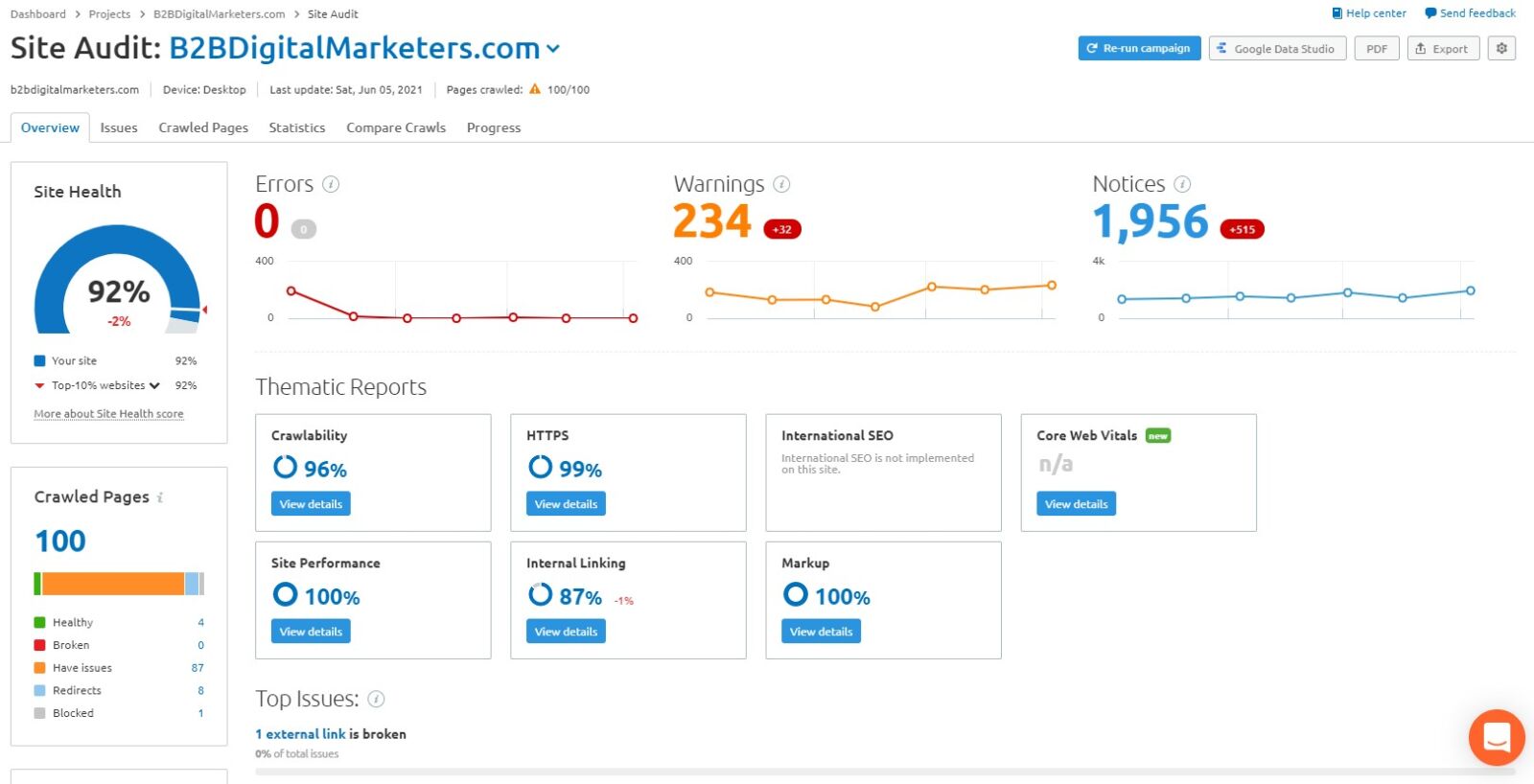
Another great SEO tool for SEO competitor analysis is SEMRush.
SEMRush is by far the most complete and comprehensive SEO tool in the marketplace offering everything you could possibly want in an SEO platform.
Their SEO analysis combined with other tools like content audit and post tracking makes your job so much easier and faster. For each of the steps, I have described here in the blog posts you have several tools to help you get all the data you need and much more.
Definitely, in terms of comprehensiveness and the data you can get from SEMRush, it is the leading tool in the market, and if you are familiar with SEO tools, then there is no brainer to try SEMRush.
They also provide a limited free version that is good enough for a newbie to try it and play around with it.
Screaming Frog
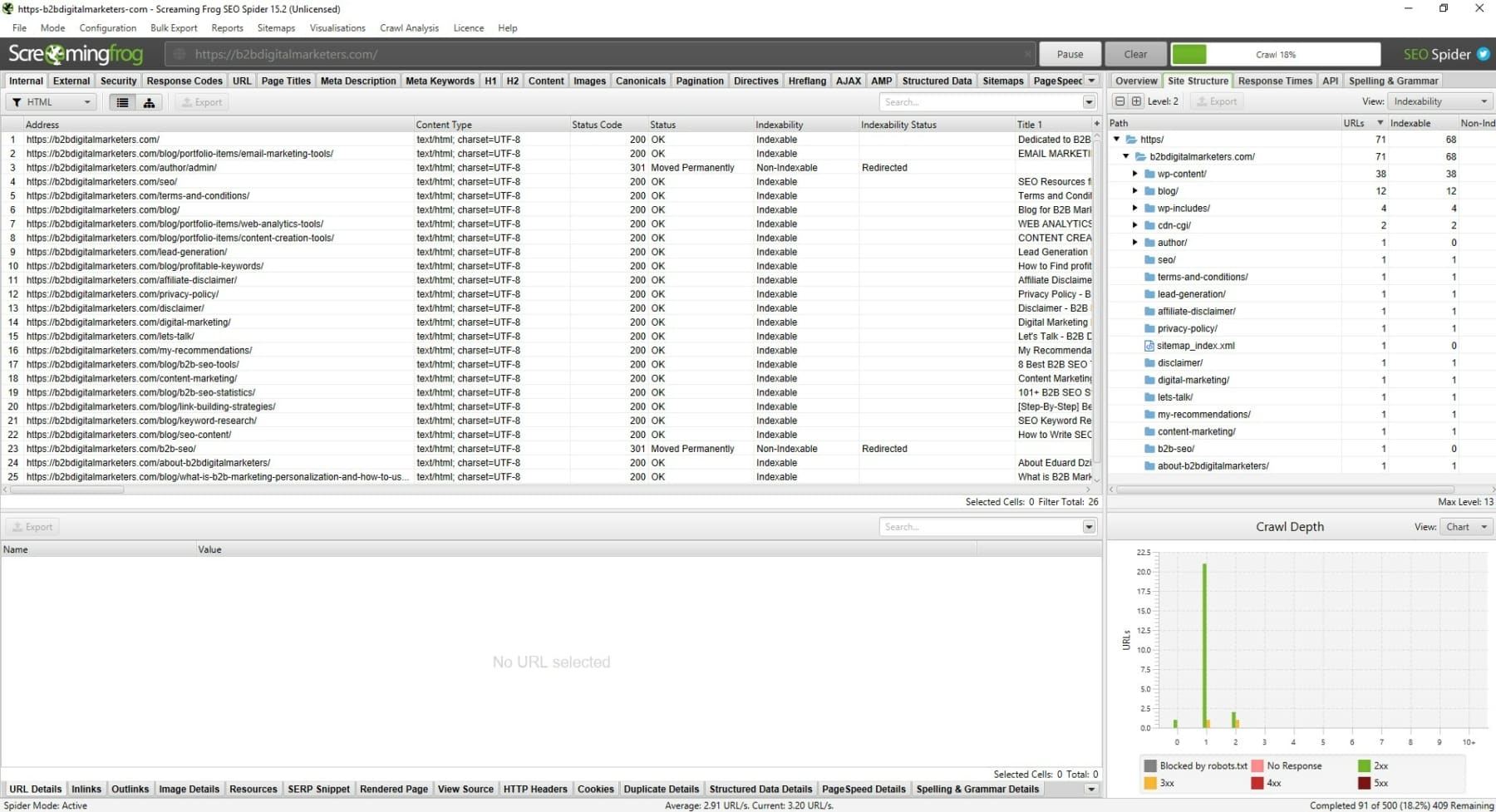
The next amazing SEO tool for SEO competitor analysis is Screaming Frog.
Regardless of what SEO tool you are using you gotta have ScreamingFrog. This tool gives you all the audit factors like meta security, links, internal links and so much more.
It makes on-page SEO and technical SEO so much easier as this is primarily a crawling tool for your website. Thus I am using this tool to crawl websites and discover errors like 404, missing meta description, improper website architecture, etc.
I also use it to run pre and post website launch crawls! It’s a great tool to help identify any glaring issues after our web development team launches a new site.
Additionally, it can be a great tool for quickly pulling website information. If we want to reoptimize meta titles and descriptions on a website we will first pull the current information using Screaming Frog. (Also, checkout Screaming Frog alternatives)
Related Articles:
- 7 Powerful B2B SEO Tips: SEO for Beginners to Rank #1 on Google in 2021
- How to Do a Content Audit for B2B Website? To Increase Organic Traffic, Leads & Ranking
- 101+ B2B SEO Statistics You Should Know in 2021
- How to Write GREAT SEO Article in 7 Steps – For Writers Beginners
- Top 12 SEO Mistakes: The Worst Mistakes You Can Probably Make Today (These Ruin Your Traffic)
- B2B SEO vs B2B SEM: What’re the Differences and Which Strategy is Better?
Also, check out our SEO hub page to find all our SEO resources.
Disclaimer
Some pictures are coming from Freepik and some of my links are affiliate links, which means if you purchase something, I might get some small commission as a reward for reference. Of course, I am actively using all these services and products, and I only affiliate products or services I have full trust in their quality!
Support the B2BDigitalMarketers
Hey, Eduard here.
As a solo blogger with limited resources, I need your support to keep creating in-depth SEO content like this. Please consider joining my Patreon community to help this site grow.
Your pledge – no matter how small – will enable me to dedicate more time to sharing actionable tips and strategies. With your help, I can take this project to the next level and really make a difference for other SEOs and marketers.
I would sincerely appreciate you joining me on this journey as a founding patron. Together, we can build an amazing resource hub. Hope to see you on the inside – thanks for your trust and support!








